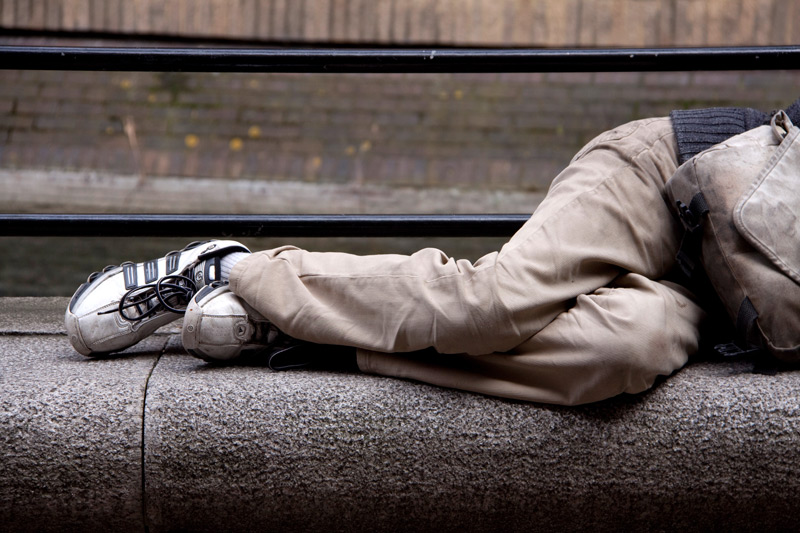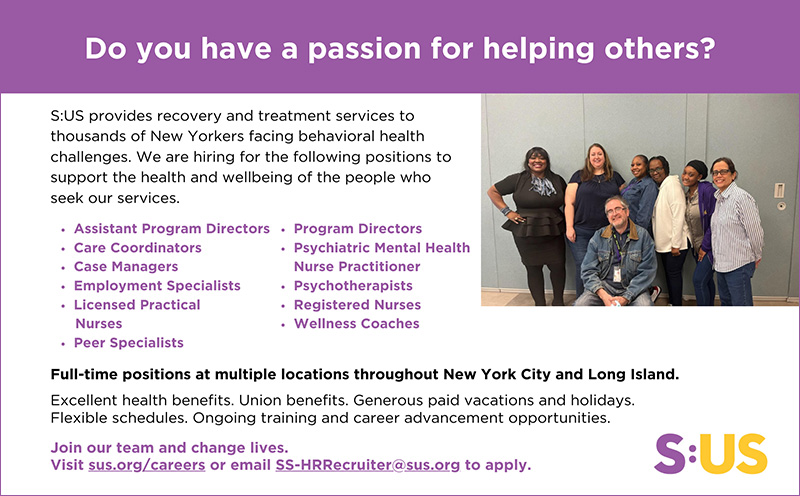Services for the UnderServed (S:US) is one the largest community-based health and human services organizations in New York State that works intentionally daily to right societal imbalances by providing comprehensive and culturally responsive services. We provide services to people living with severe mental illness, substance use disorder, homelessness, and poverty. We are cognizant of the intersectionality of severe mental illness, poverty, homelessness, and the history of the United States as it relates to caring for people who are marginalized due to disability and/or socio-economic status. We cannot begin to talk about people living with severe mental illness without looking into how mental healthcare started and progressed in America.

Before the 16th century, care for people with mental illness was the responsibility of the family.i Once mental illness was classified in the same category as physical illness and treatment methods were developed, asylums were created.i In the United States, three asylums established between 1756 and 1773 treated people using methods of bloodlettings and tranquilizer chairs, as promoted by Benjamin Rush, the pioneer of American psychiatry.iii Asylums kept people with mental illness isolated while providing treatment that did not prove to improve the conditions.iv New asylums utilizing the psychogenic frame (compassionate care and sheltered workshops) were established in New York City and Pennsylvania between 1817 and 1821 to provide care that could rehabilitate people.v By the 1850s, while the population in the asylums grew, the institutions were unable to appropriately care for all their patients due to the stagnation of their resources.vi Advocacy led by Dorothea Dix helped establish state hospitals to provide better care to people with mental illness.vii The institutional inpatient care model was deemed the most effective model of treatment until data from the National Institute of Mental Health (NIMH) and other experts demonstrated that community-oriented care combined with the use of psychotropic medications would improve the quality of care and life of people with mental illness.viii,ix However, in the mid-1950s ongoing studies conducted by the NIMH recommended deinstitutionalization and community-based care as the best approach to improve the quality of life of people with mental illness.x,xi Subsequently, partial hospitalization, emergency services, outpatient psychiatric treatment, and short-term inpatient care and smaller supervised residential homes became a substitute to institutionalizing people who required mental health treatment. xii,xiii,xiv
Regrettably, these alternatives were not comprehensive and intensive enough to effectively address the needs of people who were previously in institutions or needed a higher level of care in the community.xv Even though community-based treatment programs enhance the quality of life of people with mental illness, they are falling short in helping people with mental illness address their physical health, poverty, inadequate living conditions, and social connectedness issues in the community.xvi The population previously kept in hospitalization was now in the community at risk of homelessness, substance use disorder, suicide, and incarceration.xvii With limited availability of hospital beds compounded with inadequate community treatment options, people with severe mental illness returned to the street due to a lack of stable housing.xviii
People living with SMI experiencing homelessness continue to be a public health concern demanding attention from people who care for them, the community at large, and legislators. Many new program initiatives (Safe Options Support Teams, Welcome Centers, Intensive Mobile Treatment Teams, Safe Havens, etc.) have been implemented in New York City to address the issue of chronic homelessness. Services for the UnderServed (S:US) engages with people living with SMI in our various homeless and domestic violence shelters; people living on the streets and subways as well as those receiving services at our Certified Community Behavioral Health Clinics (CCBHC).
Our staff approach persons served with the understanding that SMI is a complex illness that must be addressed with creativity, compassion, and patience. We are deliberate in hiring persons with “lived experience” as we aim to foster an environment where those served feel understood, empowered, and encouraged. Utilizing staff who appropriately share their past experiences related to homelessness, poverty, mental illness, racism, and other forms of oppression, normalizes and externalizes some of the battle persons served are struggling with. All of our staff are provided with a series of trainings that help them to explore their own biases around people who are homeless and those with severe mental health disorders. They learn how to promote engagement through the concept of accompaniment and that persons served are the subjects in their recovery journey, and, we serve as a supportive partner. Staff are expected to approach persons served using the harm reduction lens which for people living with SMI means celebrating small successes (i.e., be ok with person served only communicating in five-minute increments; facilitating shorter groups for 20 minutes rather than 45-minute groups, etc.).
Establishing the rapport and professional relationship that will help persons served adjust to their temporary living arrangement is a principle responsibility of staff. Once there is rapport and a professional relationship, staff can begin to guide and assist persons served with achieving their chosen goals; staff with lived experience are such an intricate part of this recovery process. Some examples of being supportive is evidenced by staff creating the space for persons served to be themselves, be accepting of persons served exhibiting symptoms that are non-life threatening, and promoting connection to mental health providers at our CCHBC clinics who understand the intersection between homelessness, racism, and poverty. While working on helping persons served honor their own agency, staff’s focus does not lose sight of the ultimate goal of moving them out of the shelter to their home. With our single point of access, our teams do their best to find the most appropriate level of housing that will allow for persons served to remain housed and improve their quality of life.
Whether informal or formal, our staff provides the necessary support and assistance needed for persons served living with SMI to achieve their chosen goals outlined in their independent living and treatment plans. Our core values reflect a system where we maximize individual potential. Therefore, living with SMI and being homeless should not limit the interventions to the traditional goals of avoiding hospitalization and obtaining housing. S:US’ commitment of taking care of people with SMI who are homeless is affirmed daily through our actions, programming, and celebration of all successes small or big.
Nadjete Natchaba, EdD, LCSW, MPA, is Chief Program Officer, and Lisa Snider, BA, is Associate Vice President, Homeless Services, at Services for the UnderServed.
Footnotes
i. Farreras, I. (2020). History of mental illness. In R. Biswas-Diener & E. Diener (Eds.), Noba textbooks series: Psychology. DEF publishers. Retrieved from http://noba.to/65w3s7ex
ii. Jutras, M. (2017). Historical perspectives on the theories, diagnosis, and treatment of mental illness. BC Medical Journal, 59(2), 86-88.
iii. Jutras, M. (2017). Historical perspectives on the theories, diagnosis, and treatment of mental illness. BC Medical Journal, 59(2), 86-88.
iv. Knapp, M., Beecham, J., McDaid, D., & Smith, M. (2011). The economic consequences of deinstitutionalization of mental health services: Lessons from a systematic review of European experience. Health and Social Care in the Community, 19(2), 113-125.
v. Grob, N. (1994). Mad, homeless, and unwanted: A history of the care of the chronic mentally ill in America. Psychiatric Clinics of North America, 17(3), 541-558.
vi. Knapp, M., Beecham, J., McDaid, D., & Smith, M. (2011). The economic consequences of deinstitutionalization of mental health services: Lessons from a systematic review of European experience. Health and Social Care in the Community, 19(2), 113-125.
vii. Viney, W., & Zorich, S. (1982). Contribution to the history of psychology: XXIX. Dorothea Dix and the history of psychology. Psychological Reports, 50(1), 211-218. doi:10.2466/pr0.1982.50.1.211
viii. Novella, E. (2010). Mental health care and the politics of inclusion: A social systems account of psychiatric deinstitutionalization. Theoretical Medicine and Bioethics, 31, 411-427.
ix. Sontag, D. (2011, June 17). A schizophrenic, a slain worker, troubling questions. The New York Times. Retrieved from www.nytimes.com/2011/06/17/us/17MENTAL.html
x. Novella, E. (2010). Mental health care and the politics of inclusion: A social systems account of psychiatric deinstitutionalization. Theoretical Medicine and Bioethics, 31, 411-427.
xi. PBS. (2012). Treatment for mental illness. Retrieved from https://www.pbs.org/wgbh/americanexperience/features/nash-treatments-mental-illness/
xii. Lamb, H. R. L., & Weinberger, L. E. (2005). The shift in psychiatric inpatient care from hospitals to jails and prison. American Academy of Psychiatry Law, 33, 529-34.
xiii. National Council of Behavioral Health. (2020). Community mental health act. Retrieved from https://www.thenationalcouncil.org/about/national-mental-health-association/overview/community-mental-health-act/
xiv. Novella, E. (2010). Mental health care and the politics of inclusion: A social systems account of psychiatric deinstitutionalization. Theoretical Medicine and Bioethics, 31, 411-427.
xv. Sheffield, W. (2016). The community mental health ACT: Still pursuing the promise of reform fifty years later. Retrieved from https://www.ymadvocacy.org/the-community-mental-health-act-of-1963/
xvi. Martinez-Leal, R., Salvador-Carulla, L., Linehan, C., Walsh, P., Weber, G., Van Hove, G., Maatta, T., Azema, B., Haveman, M., Buono, S., Germanavicius, A., van Schrojenstein LaAntman-deValk, H., Tossebro, J., Carmen-Cara, A., Berger, D.M., & Perry, J. (2011). The impact of living arrangements and deinstitutionalisation in the health status with intellectual disability in Europe. Journal of Intellectual Disability Research, 55(9), 858-872.
xvii. Sheffield, W. (2016). The community mental health ACT: Still pursuing the promise of reform fifty years later. Retrieved from https://www.ymadvocacy.org/the-community-mental-health-act-of-1963/
xviii. Prins, S. J. (2011). Does trans institutionalization explain the overrepresentation for people with serious mental illness in the criminal justice system? Community Mental Health, 47, 716-722. doi:10.1007/s10597-011-9420y






